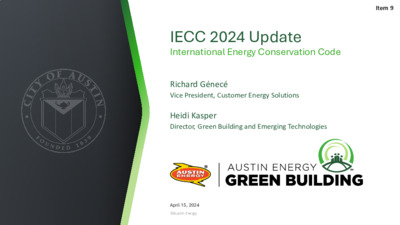Item 9_Energy Code Adoption Briefing — original pdf
Backup

Item 9 IECC 2024 Update International Energy Conservation Code Richard Génecé Vice President, Customer Energy Solutions Heidi Kasper Director, Green Building and Emerging Technologies April 15, 2024 ©Austin Energy Agenda Proposed Timeline Expected Changes Electric Vehicles & Electric Readiness Next Steps and Q&A 2 Proposed Adoption Timeline 2024 Update to International Energy Conservation Code (IECC) IECC Code published early May Stakeholder Engagement JAN FEB MAR APR MAY JUNE JULY AUG SEPT … JAN ‘25 Austin Energy Internal staff review Legal Review Affordability Impact Statement Boards and Commissions City Council Public Hearings Codes Effective January 1, 2025 3 Stakeholder Engagement • Public Comment Period • May 6 – 31 • Speak Up Austin • Available Resources • Code adoption timeline & process • Code summaries • Proposed ordinance • Austin Energy Green Building webinars as requested 4 Expected Changes – Residential 2024 IECC (Proposed) • Additional Energy Efficiency requirement point system 1. Prescriptive Path – envelope, mechanical, demand response and onsite solar options 2. Modeling Path – demonstrate up to 20% energy savings • Demand response controls required for electric water heaters • Bathroom exhaust fans require controls to remove moisture • Can include timers, occupant sensors, humidity control or contaminant control • Similar requirement in Austin Energy Green Building program • Air leakage target reduction from 5 ACH50 to 4 ACH50 • Prescriptive attic insulation requirement decreased to R38 5 Expected Changes – Commercial 2024 IECC (Proposed) • Updates specific Additional Efficiency section to align the American Society of Heating, Refrigerating and Air-Conditioning Engineers (ASHRAE) standard 90.1 2019 addendum AP • Energy Storage Systems (ESS) installed or ESS ready • Onsite renewable energy generation or offsite procurement options 6 Electric Vehicle Readiness 2024 IECC (Proposed) Commercial EV-capable, EV-ready or EVSE required quantities determined by building occupancy type Residential • One and two-family dwellings and townhouses = one EV-capable, EV-ready or EVSE space per dwelling • R-2 occupancies = EV-capable, EV-ready or EVSE space for 40% of dwelling units or car parking spaces, whichever is less Definitions • EV-Capable - Capacity and conduit • EV-Ready - Capacity, conduit, wiring and outlet • EVSE - Capacity, conduit, wiring, charging station 7 Electric Readiness 2024 IECC (Proposed) Commercial Residential • Requirements included in Appendix CH • Capacity to be included in load calculations • Combustion space heating • Combustion service water heating • Combustion cooking/clothes drying • Reserved space for future electric equipment • Dedicated branch circuits • Dedicated branch circuit outlets shall be installed and terminate within three feet of and with a rating not less than • Cooking appliances: 240-volts, 40-amps • Clothes dryers: 240-volts, 30-amps • Water heaters: 240-volts, 30-amps or 120V, 20-amps • Exceptions allowed for equipment not installed or serving multiple dwelling units 8 Space Clearances Research Austin Energy Green Building is contacting local and national partners to determine the practicability of a local code amendment to include space clearances minimums for water heaters. Electrify Now Webinar: 120 Volt Plug-In Heat Pump Water Heaters 9